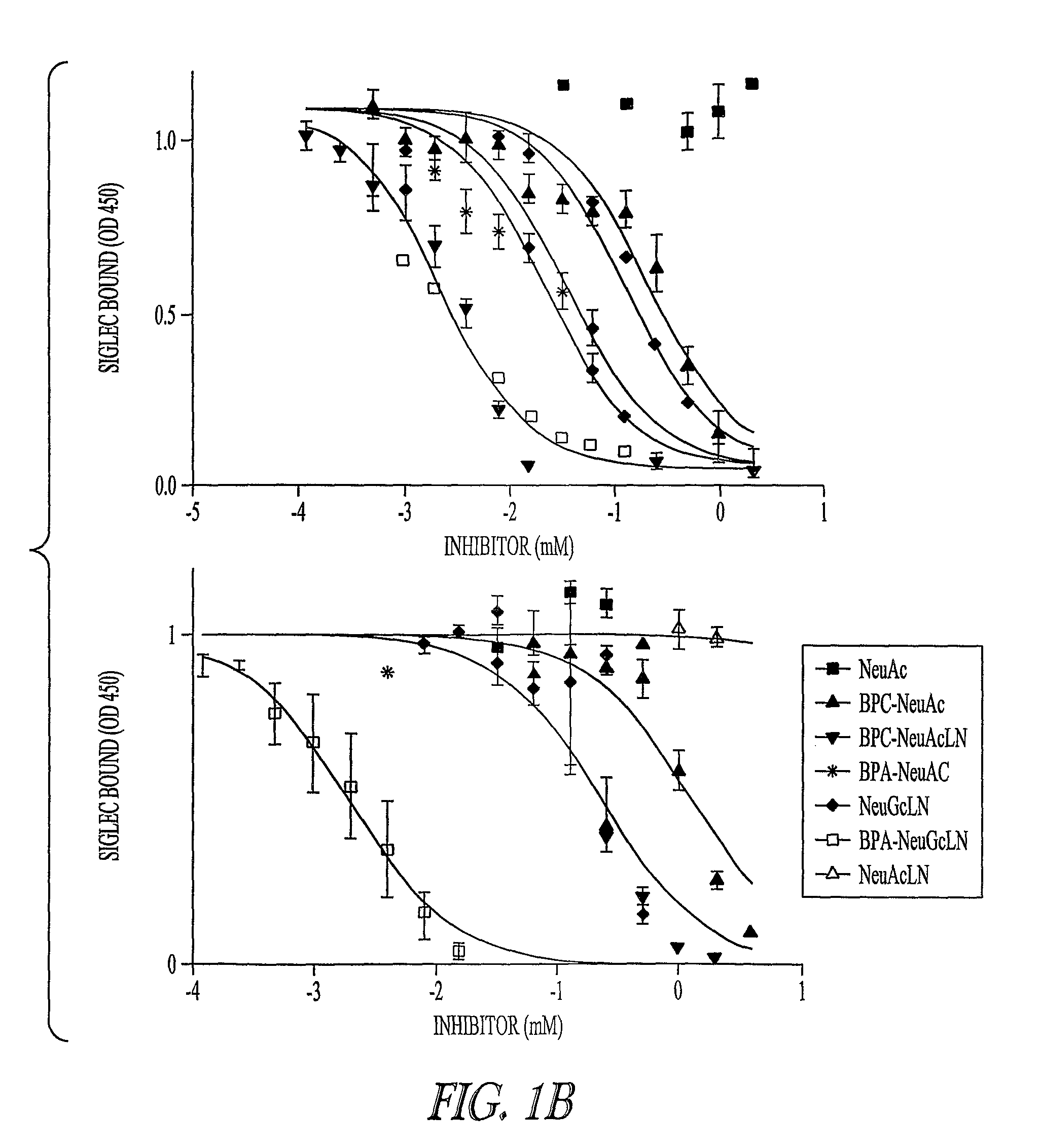High affinity Siglec ligands
a high-affinity, siglec technology, applied in the field of ligands for siglecs, can solve the problems of reducing the doubling time of malignant b-cells, increasing patient symptomatology, and limited utility of traditional methods of treating b-cell malignancies, including chemotherapy and radiotherapy
- Summary
- Abstract
- Description
- Claims
- Application Information
AI Technical Summary
Benefits of technology
Problems solved by technology
Method used
Image
Examples
example 1
Experimental Procedures
[0196]This Example describes some of the materials and methods used to analyze some of the aspects of the invention.
[0197]Antibodies and cell and mouse lines. CD22 null mice in C57B1 / 6 background were generated as described in Nitschke et al. Curr. Biol. 7: 133-43 (1997). Mice were maintained under pathogen free conditions at The Scripps Research Institute breeding facility and were used in accordance to the guidelines of the Institutional Animal Care Committee at the National Institutes of Health. BJAB, Daudi and RAJI cells were maintained in RPMI with 5% FCS or in RPMI supplemented with Neutradoma SP (Gibco), and 10 mM HEPES pH 7.0 for sera free conditions. Primary murine splenocytes were obtained from euthanized mice and then ground between two frosted glass slides and passed over a cotton plugged Pasteur to obtain single cell suspensions. Red blood cells were lysed by incubation in 0.15 M NH4Cl, 10 mM KHCO3, 0.1 mM EDTA, pH 7.2 for 5 min followed by washin...
example 2
Siaα2,6Gal Glycans Derivatized at Position 9 with a Large Hydrophobic Group and Having a Neutral Sugar Bind to CD22 with Improved Affinity
[0210]This Example demonstrates that sialosides with biphenyl groups linked in the to position 9 of the sialic acid have improved affinity for binding to CD22, especially when sialic acid is linked to a neutral saccharide such as N-acetyllactosamine in an α2,6 configuration.
[0211]Modeling studies of CD22 indicated a hydrophobic pocket in its binding site next to the 9-position carbon on the sialic acid (Zaccai et al. Structure (Camb) 11: 557-67 (2003). Accordingly, sialic acids with bulky biphenyl groups at that position were observed to be inhibitors of CD22 (Kelm et al. J. Exp. Med. 195: 1207-13 (2002)). To increase the affinity, sialosides were synthesized containing biphenyl groups at the 9 position of a sialic acid conjugated α2,6 to N-acetyllactosamine (FIG. 1A). The relative inhibitory potency (rIP) of these inhibitors was determined by mea...
example 3
Multivalent BPC-NeuAc-LN and BPA-NeuGc-LN Bind to and Internalize within CD22-Expressing B Cells
[0215]This Example demonstrates that multivalent sialosides, each with a large hydrophobic group at position 9 of a sialic acid that is linked to a neutral sugar, not only bound to native B cells but also were internalized within those B cells.
[0216]Inhibition of Probe-Binding to B cells by Sialic Acid Inhibitors. In initial studies, B cells were pretreated with sialidase to remove sialic acids and therefore unmask CD22. This was done because while B cells express CD22, they also have a high density of sialic acid-containing glycans associated with their cell surfaces. These “cis” glycan ligands can mask binding of sialic acid ligands provided in “trans.” After treatment with sialidase, inhibition of B cell binding by monovalent BPC-NeuAc-LN and BPA-NeuGc-LN was detected for multivalent polyacrylamide (PAA) sialoside probes derivatized with NeuAc-LN (hCD22) or NeuGc-LN (mCD22) (FIG. 2). I...
PUM
| Property | Measurement | Unit |
|---|---|---|
| pH | aaaaa | aaaaa |
| concentration | aaaaa | aaaaa |
| time | aaaaa | aaaaa |
Abstract
Description
Claims
Application Information
 Login to View More
Login to View More - R&D
- Intellectual Property
- Life Sciences
- Materials
- Tech Scout
- Unparalleled Data Quality
- Higher Quality Content
- 60% Fewer Hallucinations
Browse by: Latest US Patents, China's latest patents, Technical Efficacy Thesaurus, Application Domain, Technology Topic, Popular Technical Reports.
© 2025 PatSnap. All rights reserved.Legal|Privacy policy|Modern Slavery Act Transparency Statement|Sitemap|About US| Contact US: help@patsnap.com



